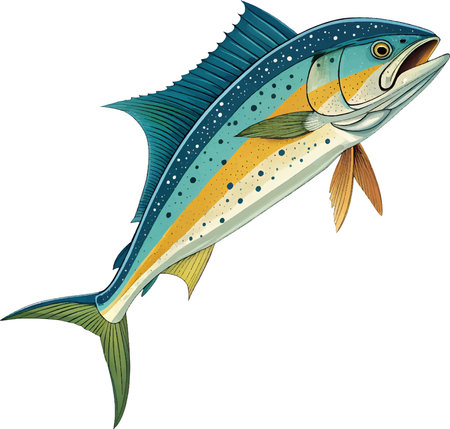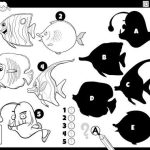1. Freshwater vs. Saltwater Catches
When youre out fishing and camping across the U.S., what you catch can vary a lot depending on whether youre near a lake or the ocean. Both freshwater and saltwater fish offer unique flavors, textures, and cooking options that can turn your campsite meal into something special. Let’s break down the key differences to help you know what to expect—and how to cook it right over the campfire.
Flavor and Texture Differences
Freshwater fish like bass, trout, and catfish tend to have a milder flavor and softer texture. These are great for simple recipes where you can let the natural taste shine—think foil packets or pan-frying over your camp stove. Saltwater fish like snapper, grouper, or mackerel often have a bolder, sometimes slightly briny flavor with firmer flesh, making them ideal for grilling or skewers.
Common Fish You Might Catch While Camping
| Type | Common Fish | Taste Profile | Best Cooking Methods |
|---|---|---|---|
| Freshwater | Bass, Trout, Catfish, Bluegill | Mild, sometimes sweet; tender texture | Foil packet grilling, pan-frying, smoking |
| Saltwater | Snapper, Mahi-Mahi, Flounder, Redfish | Bolder flavor; firm and flaky texture | Grilling, open-flame roasting, kabobs |
Cooking Tips by Water Type
Freshwater Fish:
- Trout: Clean it up and stuff with lemon slices and herbs. Wrap in foil and place directly on hot coals.
- Catfish: Best when breaded with cornmeal and pan-fried crispy in a cast-iron skillet.
- Bass: Great for smoking if you’re camping longer—just use wood chips from nearby hardwood trees if available.
Saltwater Fish:
- Mahi-Mahi: Slice into thick fillets and grill with olive oil and lime juice for a tropical twist.
- Snapper: Whole-grilled snapper works well—just score the skin so it cooks evenly.
- Flounder: Delicate enough for steaming in foil with garlic butter and chopped veggies.
The Right Prep Makes All the Difference
No matter what type of fish you catch while camping, fresh is always best. Clean your catch as soon as possible (and safely), keep it cool until cooking time, and season simply—salt, pepper, citrus juice, and maybe a little garlic go a long way when youre cooking outdoors. Whether its lake trout or sea snapper sizzling on your campfire grill, knowing your fish helps make every bite better under the stars.
2. Essential Campfire Cooking Gear
When youre out fishing and camping, having the right cooking gear can make all the difference between a memorable outdoor meal and a hungry night under the stars. Whether you’re grilling your fresh catch or whipping up hearty sides, here’s a practical guide to must-have tools and cookware that will help you cook like a pro in the wild.
Must-Have Campfire Cooking Tools
To cook over an open flame or portable stove, youll need gear that’s tough, reliable, and easy to pack. Here are some essentials every angler-camper should bring along:
| Gear | Description | Why You Need It |
|---|---|---|
| Cast Iron Skillet | Heavy-duty pan that retains heat well | Perfect for searing fish, frying bacon, or making cornbread |
| Portable Grill Grate | Metal grate that fits over your fire pit or coals | Makes it easy to grill fish or vegetables over open flame |
| Campfire Tripod or Cooking Stand | A stand to hang pots or kettles over a campfire | Great for boiling water or slow-cooking stews and soups |
| Foldable Table & Food Prep Station | Lightweight surface for prepping meals | Keeps your ingredients clean and organized |
| Long-Handled Tongs & Spatula | Heat-resistant tools designed for campfire use | Keeps your hands safe while flipping fish or turning meat |
| Fire Starters & Waterproof Matches | Reliable ignition tools for all weather conditions | You can’t cook without fire—be ready rain or shine! |
Pots, Pans & Utensils for Outdoor Cooking
Your kitchen in the wild doesn’t have to be fancy, but it does need to be functional. Consider packing these cooking basics:
- Coffee Percolator: Nothing beats a hot cup of coffee at sunrise by the lake.
- Nesting Cookware Set: Space-saving sets usually include pots, pans, and lids.
- Ladle and Serving Spoon: Great for serving up chowders or stews made from your catch.
- Cutting Board and Sharp Knife: Essential for cleaning fish and chopping veggies.
- Tin Foil: A campers secret weapon—use it to wrap fish, potatoes, or veggies and toss them straight into the coals.
Optional but Handy Extras
- Thermometer: Helps ensure meats (and even thick fish fillets) are cooked safely.
- Cowboy-style Dutch Oven: Ideal for baking biscuits, roasting meats, or simmering chili.
- Campsite Sink or Water Jug with Spout: For easy cleanup and washing produce.
Packing Tips for Campfire Cooking Gear
The best setup is one that balances comfort with portability. Store smaller items inside larger pots to save space. Use plastic bins or soft-sided totes to organize your cooking gear so everything’s easy to grab when hunger hits. And don’t forget trash bags—leave no trace!
The right gear means you can enjoy delicious meals without stress—even if the fish aren’t biting. With these essentials in your pack, youll be ready to cook up whatever the wilderness (or your fishing line) provides.

3. Easy Make-Ahead Meals and Snacks
When youre out in the wild waiting for the fish to bite or sitting around the campfire, having quick and easy meals ready to go can make a big difference. Whether you’re fishing by a quiet lake or camping deep in the woods, make-ahead food keeps you energized without pulling you away from the action.
Why Pre-Made Food Works Great Outdoors
Make-ahead meals save time, reduce mess, and help you stay focused on fishing and enjoying nature. They’re perfect for early mornings when you want to get straight to casting your line or after a long hike back from your favorite fishing spot.
Top Make-Ahead Meal and Snack Ideas
Here are some easy-to-prep foods that travel well, taste great cold or hot, and give you the energy boost you need:
| Meal/Snack | Description | Storage Tips |
|---|---|---|
| Breakfast Burritos | Scrambled eggs, sausage, cheese, and veggies wrapped in a tortilla. Freeze ahead and reheat over the fire. | Wrap in foil; store in cooler or freeze before trip |
| Trail Mix | A mix of nuts, dried fruit, seeds, and chocolate for quick energy between casts. | Keep in sealed zip bags or small containers |
| Mason Jar Salads | Layered salads with dressing at the bottom; just shake and eat when ready. | Store upright in cooler to keep fresh |
| Pasta Salad | A cold pasta dish with veggies, cheese, and protein like chicken or tuna. | Pack in airtight container; keep chilled |
| Peanut Butter Wraps | Tortillas spread with peanut butter, honey, and banana slices — no refrigeration needed! | Wrap in parchment or plastic wrap; keep dry |
| Energy Bars | Homemade or store-bought bars loaded with oats, nut butter, and seeds. | Keep in backpack for quick grab-and-go fuel |
Tips for Packing Your Food Right
Keep It Cold Where Needed
A good quality cooler with ice packs can keep items like burritos and salads fresh for days. Always store raw fish separately from ready-to-eat foods.
Use Reusable Containers
Mason jars, bento boxes, and reusable silicone bags not only cut down on trash but also keep your food sealed tight during transport.
Label Everything
If you’re bringing multiple pre-made meals, label them with contents and dates so you know what to eat first.
The Bottom Line on Make-Ahead Meals
You don’t need gourmet cooking skills to eat well while fishing and camping. With a little prep before your trip, youll have hearty meals and snacks ready when hunger strikes—so you can focus more on catching that big one instead of cooking over the fire every time.
4. Cook What You Catch: Camp Recipes
There’s nothing like enjoying a freshly caught fish cooked over an open flame at your campsite. Whether you’ve reeled in trout, bass, or catfish, these step-by-step campfire recipes use simple ingredients and minimal gear—perfect for outdoor cooking.
Trout Foil Packets
Ingredients:
- 1 whole trout (cleaned and gutted)
- 1 tablespoon olive oil
- Lemon slices
- Fresh herbs (like dill or parsley)
- Salt and pepper to taste
- Aluminum foil
Steps:
- Lay out a sheet of aluminum foil large enough to wrap the fish.
- Drizzle olive oil on the foil and place the trout on top.
- Stuff the cavity with lemon slices and herbs.
- Season with salt and pepper.
- Wrap tightly and place on hot campfire coals for 10-15 minutes, flipping halfway through.
- Carefully unwrap and enjoy directly from the foil!
Grilled Bass with Garlic Butter
Ingredients:
- Bass fillets (skin-on)
- 2 tablespoons butter
- 2 cloves garlic (minced)
- Lemon juice (optional)
- Salt and pepper to taste
Steps:
- Melt butter in a small pan over the fire and add minced garlic. Cook until fragrant.
- Brush both sides of the bass fillets with garlic butter.
- Season with salt and pepper.
- Place skin-side down on a grill grate or cast iron pan over the fire.
- Cook for about 3-5 minutes per side until the fish flakes easily with a fork.
- Squeeze lemon juice on top before serving if desired.
Campfire Fried Catfish
Ingredients:
- Catfish fillets
- 1 cup cornmeal
- 1/2 cup flour
- Cajun seasoning or salt & pepper to taste
- Oil for frying (vegetable or canola)
You’ll Need:
- A cast iron skillet or Dutch oven
- A heat-safe spatula or tongs
Steps:
- Mix cornmeal, flour, and seasoning in a zip-top bag or bowl.
- Dredge catfish fillets in the mixture until fully coated.
- Add oil to your skillet and place it over hot coals or a grill grate.
- Once the oil is hot (test with a small piece of bread—it should sizzle), carefully add fillets.
- Fry for about 3-4 minutes per side until golden brown and crispy.
- Remove and drain on paper towels or clean cloth. Serve hot!
Quick Ingredient Comparison Table
| Fish Type | Main Ingredients | Cooking Method |
|---|---|---|
| Trout | Lemon, herbs, olive oil | Baked in foil over coals |
| Bass | Garlic butter, lemon juice | Grilled over open flame |
| Catfish | Cornmeal, flour, Cajun spice | Panfried in skillet over fire |
No matter which catch you’re cooking up, keeping it simple is key when youre out camping. These recipes bring out the natural flavor of fresh fish using basic seasonings and easy campfire techniques that anyone can master right at their campsite.
5. Savor the Outdoors: Pairings and Extras
When youre out fishing and camping, the fresh air and good company make everything taste better. But why not take it up a notch? Pairing your freshly caught fish with the right sides, sauces, and drinks can turn a simple camp meal into an unforgettable outdoor feast.
Savory Sidekicks
Great sides don’t have to be complicated. Here are a few easy-to-pack or easy-to-make options that go perfectly with grilled or pan-fried fish:
| Side Dish | Why It Works |
|---|---|
| Grilled Corn on the Cob | Sweet and smoky flavor complements fish beautifully. |
| Campfire Potatoes | Hearty and filling, they absorb all the delicious juices from your fish. |
| Coleslaw | Crisp and tangy – adds crunch and balances oily fish. |
| Baked Beans | Slightly sweet with a hint of spice; great with smoked or blackened fish. |
| Foil-Pack Veggies | Easy to cook over fire; zucchini, bell peppers, and onions bring color and texture. |
Sauces to Boost Flavor
A good sauce can elevate your catch from tasty to unforgettable. These are simple enough for camping but packed with flavor:
| Sauce | Best With | Quick Tip |
|---|---|---|
| Lemon Herb Butter | Trout, bass, walleye | Melt butter, mix in chopped herbs & lemon juice. |
| Tartar Sauce (pre-made) | Panfried crappie or bluegill | Bring it in a small squeeze bottle – no mess! |
| Sriracha Mayo | Blackened catfish or perch | Mix equal parts mayo and sriracha for a kick. |
| Pico de Gallo | Grilled tilapia or snapper (if saltwater fishing) | Doubles as a chip dip too! |
| Garlic Aioli (prepped ahead) | Salmon or trout burgers | Keeps well in a cooler for 1–2 days. |
Drinks That Hit the Spot
You’ll want something cold and refreshing after a long day outdoors. Here are some drink ideas that go great with fish around the campfire:
Non-Alcoholic Options:
- Iced Tea – Add lemon slices for extra zing.
- Lemonade – Tart and sweet, pairs well with fried or spicy dishes.
- Cucumber Water – Super refreshing after being in the sun all day.
- Canned Sparkling Water – Easy to pack, lots of flavors available.
If You’re of Age (and allowed at your campsite):
- Craft Beer – Light lagers or wheat beers pair well with most fish.
- Canned Wine – Easy to transport; white wine is best for lighter fish dishes.
- Bourbon + Cola – A bold mix that stands up to strong-flavored grilled fish like salmon.
Don’t Forget the Fun Extras!
Add some fun finishing touches to your camp meals:
- Lemon wedges for squeezing over fish just before eating.
- A pinch of sea salt or smoked paprika sprinkled on top adds depth of flavor.
- Cornbread muffins made ahead at home travel well and complement many dishes.
- Tortillas – Turn leftover grilled fish into quick tacos for lunch the next day!
The joy of fishing and camping isn’t just about catching dinner—it’s about enjoying every bite under the open sky. With these easy pairings and extras, you’re sure to make every meal one to remember out there in nature.


